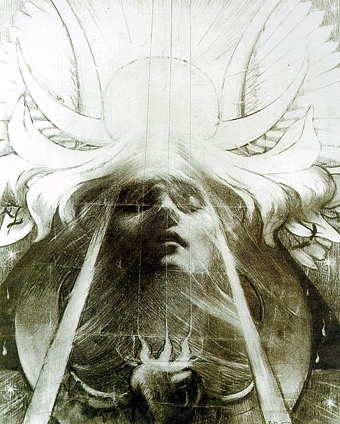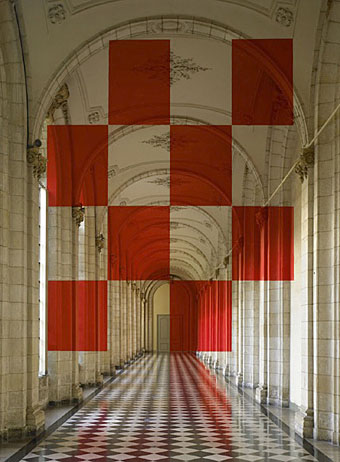Day of the Dead
| Robert Hughes excoriates Damien Hirst.
Category: {painting}
Painting
Painted screams
Painted screams
| Adrian Searle on the Bacon retrospective.
The faces of Parsifal

Parsifal by Jean Delville (1890).
Continuing the occasional series of posts examining the evolution of a particular design or image, this one begins with a mystical charcoal drawing by Belgian Symbolist, Jean Delville (1867–1953), our object of concern being that entranced or dreaming face.
 My first encounter with Delville’s image wasn’t via the original but came with this Seventies’ version produced for a Charles Williams paperback cover by illustrator Jim Lamb. (And this copy is the only one I can find, reused on a recent audiobook of Williams’ novel. If anyone has a link to a larger copy of the paperback cover then please post it in the comments.) Yes, this is tenuous but when I eventually got to see Delville’s picture it made me think immediately of Lamb’s illustration. Many Dimensions is one of my favourite books by Williams and unusually for him it deals with Islamic rather than Christian mysticism; in that case if Lamb was borrowing from Parsifal then it’s a case of the right image for the wrong book.
My first encounter with Delville’s image wasn’t via the original but came with this Seventies’ version produced for a Charles Williams paperback cover by illustrator Jim Lamb. (And this copy is the only one I can find, reused on a recent audiobook of Williams’ novel. If anyone has a link to a larger copy of the paperback cover then please post it in the comments.) Yes, this is tenuous but when I eventually got to see Delville’s picture it made me think immediately of Lamb’s illustration. Many Dimensions is one of my favourite books by Williams and unusually for him it deals with Islamic rather than Christian mysticism; in that case if Lamb was borrowing from Parsifal then it’s a case of the right image for the wrong book.
Jim Lamb is another illustrator from this period who now works mainly as a landscape artist.
A mind on fire
A mind on fire
| Jonathan Jones on Francis Bacon.
Anamorphosis by Felice Varini
Huite rectangles (2007).
Amazing architectural redecoration by Swiss artist Felice Varini.
Previously on { feuilleton }
• Abelardo Morell’s camera obscura

